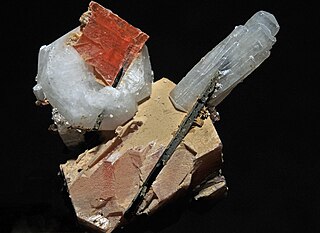
In geology and mineralogy, a mineral or mineral species is, broadly speaking, a solid substance with a fairly well-defined chemical composition and a specific crystal structure that occurs naturally in pure form.
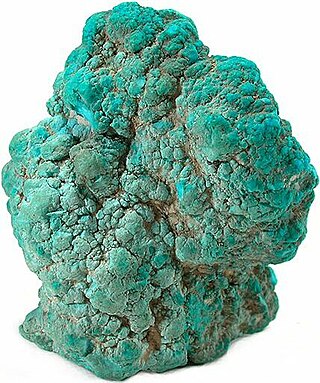
Turquoise is an opaque, blue-to-green mineral that is a hydrous phosphate of copper and aluminium, with the chemical formula CuAl6(PO4)4(OH)8·4H2O. It is rare and valuable in finer grades and has been prized as a gemstone for millennia due to its hue.
Lustre is the way light interacts with the surface of a crystal, rock, or mineral. The word traces its origins back to the Latin lux, meaning "light", and generally implies radiance, gloss, or brilliance.

Vanadinite is a mineral belonging to the apatite group of phosphates, with the chemical formula Pb5(VO4)3Cl. It is one of the main industrial ores of the metal vanadium and a minor source of lead. A dense, brittle mineral, it is usually found in the form of red hexagonal crystals. It is an uncommon mineral, formed by the oxidation of lead ore deposits such as galena. First discovered in 1801 in Mexico, vanadinite deposits have since been unearthed in South America, Europe, Africa, and North America.

Anglesite is a lead sulfate mineral with the chemical formula PbSO4. It occurs as an oxidation product of primary lead sulfide ore, galena. Anglesite occurs as prismatic orthorhombic crystals and earthy masses, and is isomorphous with barite and celestine. It contains 74% of lead by mass and therefore has a high specific gravity of 6.3. Anglesite's color is white or gray with pale yellow streaks. It may be dark gray if impure.
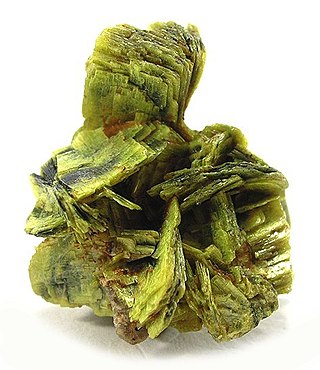
Autunite (hydrated calcium uranyl phosphate), with formula Ca(UO2)2(PO4)2·10–12H2O, is a yellow-greenish fluorescent phosphate mineral with a hardness of 2–2+1⁄2. Autunite crystallizes in the orthorhombic system and often occurs as tabular square crystals, commonly in small crusts or in fan-like masses. Due to the moderate uranium content of 48.27% it is radioactive and also used as uranium ore. Autunite fluoresces bright green to lime green under UV light. The mineral is also called calco-uranite, but this name is rarely used and effectively outdated.

Vivianite (Fe2+
3(PO
4)
2·8H
2O) is a hydrated iron phosphate mineral found in a number of geological environments. Small amounts of manganese Mn2+, magnesium Mg2+, and calcium Ca2+ may substitute for iron Fe2+ in the structure. Pure vivianite is colorless, but the mineral oxidizes very easily, changing the color, and it is usually found as deep blue to deep bluish green prismatic to flattened crystals.
Vivianite crystals are often found inside fossil shells, such as those of bivalves and gastropods, or attached to fossil bone.
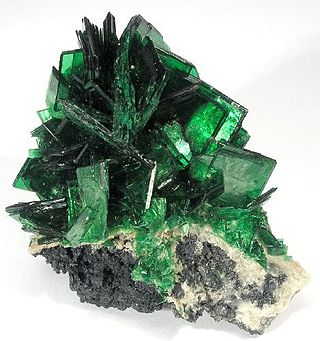
Torbernite, also known as chalcolite, is a relatively common mineral with the chemical formula Cu[(UO2)(PO4)]2(H2O)12. It is a radioactive, hydrated green copper uranyl phosphate, found in granites and other uranium-bearing deposits as a secondary mineral. The chemical formula of torbernite is similar to that of autunite in which a Cu2+ cation replaces a Ca2+ cation. Torbernite tends to dehydrate to metatorbernite with the sum formula Cu[(UO2)(PO4)]2(H2O)8.
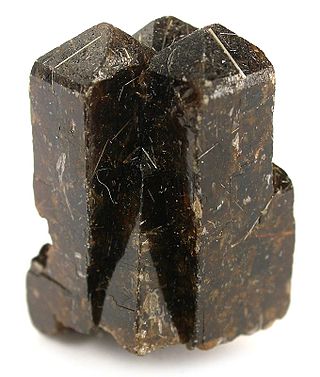
Xenotime is a rare-earth phosphate mineral, the major component of which is yttrium orthophosphate (YPO4). It forms a solid solution series with chernovite-(Y) (YAsO4) and therefore may contain trace impurities of arsenic, as well as silicon dioxide and calcium. The rare-earth elements dysprosium, erbium, terbium and ytterbium, as well as metal elements such as thorium and uranium (all replacing yttrium) are the expressive secondary components of xenotime. Due to uranium and thorium impurities, some xenotime specimens may be weakly to strongly radioactive. Lithiophyllite, monazite and purpurite are sometimes grouped with xenotime in the informal "anhydrous phosphates" group. Xenotime is used chiefly as a source of yttrium and heavy lanthanide metals (dysprosium, ytterbium, erbium and gadolinium). Occasionally, gemstones are also cut from the finest xenotime crystals.

Heulandite is the name of a series of tecto-silicate minerals of the zeolite group. Prior to 1997, heulandite was recognized as a mineral species, but a reclassification in 1997 by the International Mineralogical Association changed it to a series name, with the mineral species being named:
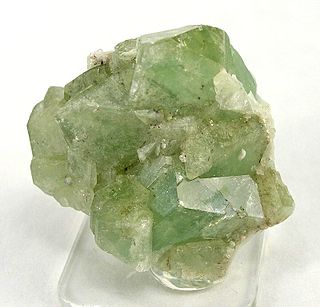
Herderite is a phosphate mineral belonging to the apatite, phosphate group, with formula CaBe(PO4)(F,OH). It forms monoclinic crystals, often twinned and variable in colour from colourless through yellow to green. It forms a series with the more common hydroxylherderite, which has more hydroxyl ion than fluoride.
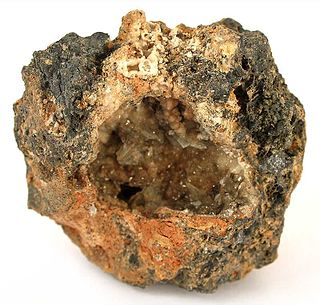
Leadhillite is a lead sulfate carbonate hydroxide mineral, often associated with anglesite. It has the formula Pb4SO4(CO3)2(OH)2. Leadhillite crystallises in the monoclinic system, but develops pseudo-hexagonal forms due to crystal twinning. It forms transparent to translucent variably coloured crystals with an adamantine lustre. It is quite soft with a Mohs hardness of 2.5 and a relatively high specific gravity of 6.26 to 6.55.
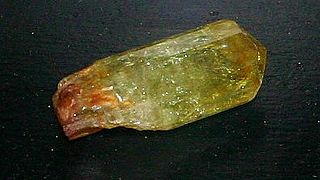
Phosphate minerals contain the tetrahedrally coordinated phosphate (PO43−) anion, sometimes with arsenate (AsO43−) and vanadate (VO43−) substitutions, along with chloride (Cl−), fluoride (F−), and hydroxide (OH−) anions, that also fit into the crystal structure.
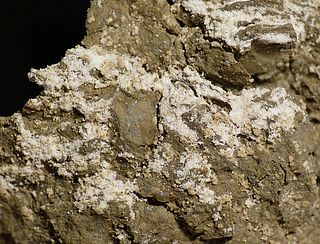
Brushite is a phosphate mineral with the chemical formula CaHPO4·2H2O. Crystals of the pure compound belong to the monoclinic space group C2/c and are colorless. It is the phosphate analogue of the arsenate pharmacolite.
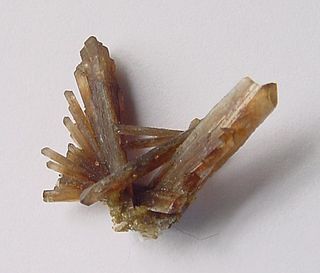
Childrenite is a rare hydrated phosphate mineral with elements iron, manganese, aluminium, phosphorus, oxygen and hydrogen. Its chemical formula is (Fe2+
,Mn)2+
AlPO
4(OH)
2•H
2O and it has a molecular weight of 229.83 g/mol. Its specific gravity is 3.2 and it has a Mohs hardness of 4.5 to 5. It is usually translucent and non-fluorescent, with imperfect cleavage. It has a vitreous lustre with a white streak, and is brown or yellow in color. It has a conchoidal, uneven fracture, and an orthorhombic crystal system.

Zeunerite is a green copper uranium arsenate mineral with formula Cu(UO2)2(AsO4)2•(10-16)H2O. It is a member of the autunite group. The associated mineral metazeunerite is a dehydration product of zeunerite.
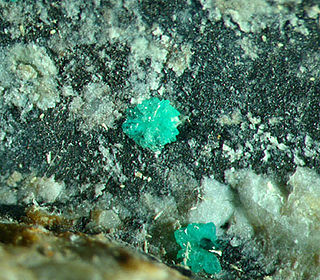
Tsumebite is a rare phosphate mineral named in 1912 after the locality where it was first found, the Tsumeb mine in Namibia, well known to mineral collectors for the wide range of minerals found there. Tsumebite is a compound phosphate and sulfate of lead and copper, with hydroxyl, formula Pb2Cu(PO4)(SO4)(OH). There is a similar mineral called arsentsumebite, where the phosphate group PO4 is replaced by the arsenate group AsO4, giving the formula Pb2Cu(AsO4)(SO4)(OH). Both minerals are members of the brackebuschite group.
Copper phosphate may refer to :
Metarauchite is a member of the autunite group, found at the Jáchymov ore district, Czech Republic and in Schneeberg, Germany. The autunite group is a group of structured uranyl phosphates and arsenates; the other members of the group are autunite, bassetite, heinrichite, kahlerite, nováčekite-I, nováčekite-II, rauchite, sabugalite, saléeite, torbernite, uranocircite, uranospinite, and zeunerite. The mineral is named after Czech mineral collector Luděk Rauch, who died in the Jáchymov mines during mineral prospecting.
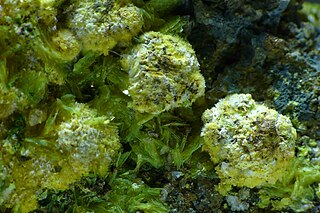
Zellerite is a uranium mineral, named after its discoverer, geologist Howard Davis Zeller. It has a type locality of the Lucky MC uranium mine in Wyoming, USA. It was approved by the IMA in 1965, but was first published a year after its approval.


















